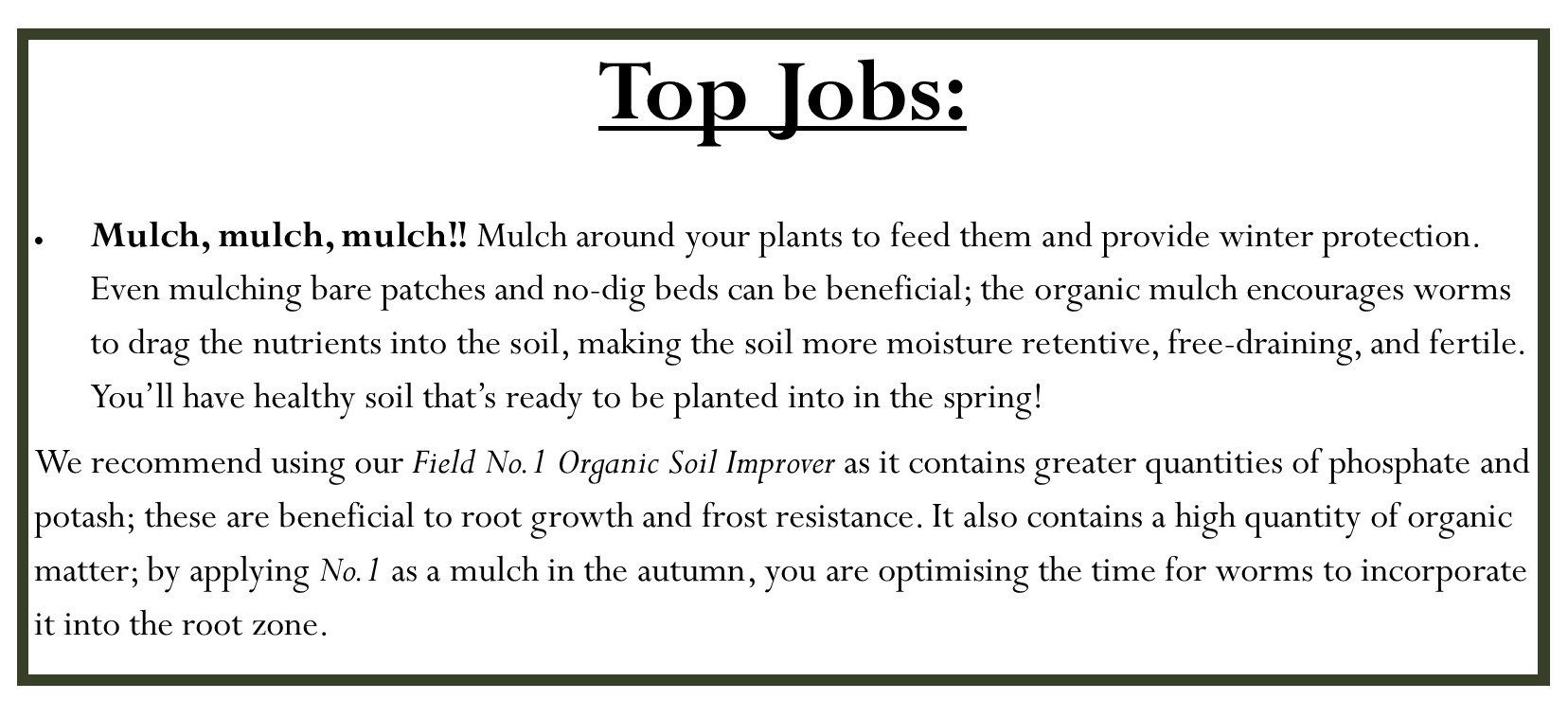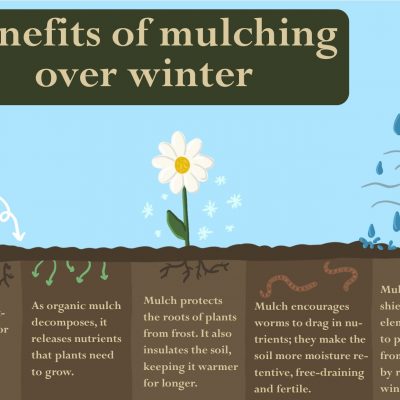Happy October! Its autumn and a very spooky month – have you been growing pumpkins for Halloween?
October at Field Compost is expected to be busy, with lots of customers using our Lawn Dressing for their autumn lawncare maintenance and renovations. All of our agricultural and gardening shows are finished for the year, so we have a bit more time to spare! What else is new… ah yes, we are now stocking Sturmer Garden Centre (again); if you live near Haverhill, Suffolk, you can pick up our No.1 Soil Improver, No.6 topsoil, No.23 Potting Blend compost, and No.9 Play Bark!

Check out our blog post on the benefits of mulching in winter!
General Garden Maintenance:
- Rake up fallen leaves from lawns, borders, driveways and paths; store them in a bin to rot down into leaf mould.
- Build a log pile at the back of your garden or a border, for wildlife to shelter in.
- Gather up canes and plant support that are no longer in use, and store indoors over winter.
- Clean water butts by emptying them and washing them with a hose, or by scrubbing them with a brush. They will then be ready to catch the extra water expected at this time of year.
Greenhouse:
- Clean out your greenhouse to get rid of debris that can harbour overwintering pests and diseases.
- Ventilate greenhouses and conservatories during the remaining warmer days, but reduce the ventilation once cooler, gusty autumn weather sets in.
- Water your plants more sparingly as conditions turn cooler and the days get shorter.
- If not done already, attach guttering to the greenhouse and install a water butt, to make good use of the inevitable autumn rain.

Houseplants:
- Feed your houseplants once a week with liquid fertiliser and continue through autumn.
- Water houseplants less frequently as days shorten and growth slows, and move them off particularly cold windowsills at night.
- Repot any houseplants that have become top heavy, or pot bound into large containers. Our No.23 Peat Free Potting Blend compost is perfect for this!
Lawn:
Maintenance:
- Carry out autumn lawn care if the weather isn’t very wet or frosty, and your soil isn’t waterlogged. Scarify, aerate and top dress with Field No.4 Organic Lawn Dressing, to improve your lawn’s resilience and appearance next year. If needed, repair any damage by re-seeding bare patches; we have a lawn care bundle with our No.4 Lawn Dressing and grass seed.
- Remove fallen leaves from lawns so they don’t smother the grass and block out light and moisture. Raking is the best option, but with large lawns using a leaf blower will make the job easier.
New Lawns:
- Lay turf onto prepared soil but leave it undisturbed for several weeks to allow the new roots to establish. Spread our Field No.26 Turfing Soil before laying turf.
- Sow grass seed on prepared ground (scarified and aerated) in warmer regions of the UK. You can use Field No.5 Fine Grade Topsoil and cover with a thin layer of Field 4.
- Mow recently sown areas of grass for the first time – to neaten them up before winter. They should only need mowing once this year. Set the cutting height to at least 2.5cm.

Flowers:
Jobs:
- Lift up and pot tender perennials, e.g., chocolate cosmos, gazanias and coleus, to protect them over winter. Pot up using Field No.23 Potting Blend compost.
- Remove any pot saucers and raise pots up onto feet or bricks, to prevent them sitting in water and waterlogging over winter.
- Divide herbaceous perennials; dividing regularly will ensure healthy, vigorous plants that will continue to perform year after year.
- Perform some hanging basket maintenance: deadheading, watering and feeding can keep them going until mid-autumn. Once they are past their best, re-plant with spring-flowering bulbs, trailing ivies, winter heathers, and spring bedding plants.
To plant:
- Spring flowering bulbs. Plant drifts of bulbs informally in your lawn, e.g., crocuses, daffodils, allium and fritillaries. Mix Field No.1 Organic Soil Improver with the existing soil around the bulbs, to add nutrition and organic matter.
- Sow sweet peas in deep pots in the greenhouse, for early flowers next summer.
- Hardy annuals. October marks the final sowings of hardy annuals to overwinter for an early flush of spring flowers. For instance, phacelia is a great plant for bees and other pollinators. Sow these direct in well-prepared soil (mix Field No.23 in drills) or in a seed tray (of No.23) for planting out in spring.
- Also the final sowing of perennials that need a cold spell to aid germination, e.g., primulas and cowslips. Cowslips are a tough perennials that do best in a partially shady spot near water, like the pond edge. Fresh seeds need a cold period to germinate so sow in October in seed trays or multi-celled trays. Fill trays with Field No.23 Potting Blend compost.

Fruit & Veg:
Jobs:
- Cover salad plants with cloches to prolong cropping.
- Divide large clumps of herbs, e.g., chives, lemon balm and marjoram, then replant them or share with friends.
- Cut fruited stems of blackberries and autumn raspberries down to the ground after harvesting.
- Harvest the last of your crops, e.g., runner beans, courgettes, pumpkins, squash, and maincrop potatoes.
To plant:
- Peas. For an early crop next spring, sow hardy cultivars like ‘Avola’ and ‘Meteor’ peas now. Sow them direct in 5cm drills in the ground, mixing in Field No.23, or in root trainers to plant out in a couple of weeks. Its also a good time to plant out peas sown in root trainers or guttering in September.
- Hardy broad beans. Sow this month to germinate and put on some growth before entering winter dormancy. They will provide a spring harvest a few weeks earlier than spring-sown plants. Sow direct in the soil (mix Field No.23 in drills) or in multi-celled trays (of No.23) to plant out in a couple of weeks.
- Cauliflower. Early-summer cropping cultivars, e.g., ‘Snowball’ can be sown now to overwinter, and then planted out in spring. Sow in multi-celled trays of No.23 and thin out to one seedling per cell, then plant out in spring.
- Rhubarb crowns. These can be planted now, and established clumps can be divided. Mix Field No.1 Organic Soil Improver in with the soil when planting.
- Salad mixes are easy to grow! Sowing in early October may get you a small crop before winter, but then plants will enter dormancy and not start growing again until March. Sow in pots that you can move into the greenhouse or indoors for shelter.
- Herbs, e.g., basil, dill, chives and parsley. Seeds can be sown now and grown on windowsills throughout winter. Use Field No.23 Potting Blend compost.

Trees & shrubs:
Jobs:
- Move deciduous shrubs that are in the wrong place or have outgrown their current position. Mix Field No.1 Soil Improver into the planting pit.
- Trim deciduous hedges to keep them looking tidy over the winter.
- Prune climbing roses. This is best done in late autumn and winter, once leaves have fallen. Pruning will keep your roses healthy, well-trained and will enhance their flowering display.
- Check tree ties and stakes before winter gales cause damage. Replace them if necessary and if needed replace the twine.
To plant:
When planting, mix Field No.1 Organic Soil Improver with the existing soil of the planting pit.
- Bare-root fruit trees like apples and pears, and fruiting shrubs, e.g., blackcurrants, gooseberries, and currents. Order them to plant out from late autumn to early spring, although it is best to plant them out as soon as they arrive, as it gives them the best chance of becoming established before temperatures fall.
- Containerised trees and shrubs, and large semi-mature specimens can still be planted over winter.
- Plant evergreen shrubs and conifer hedges while the soil is still warm.
